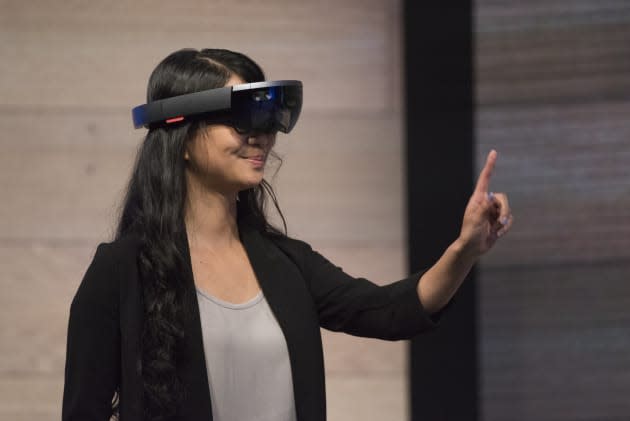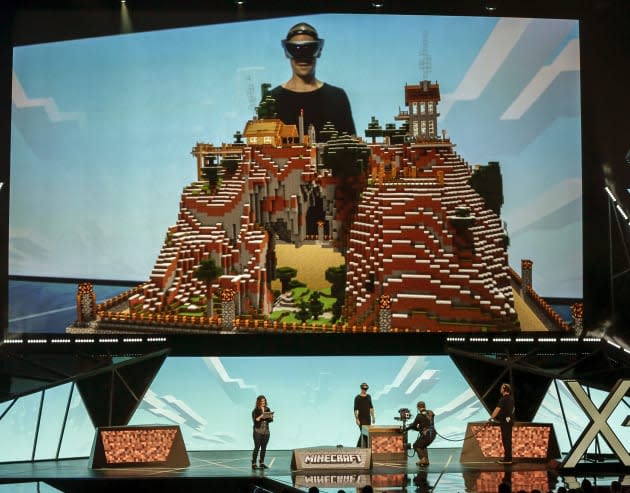I played 'Minecraft' with Microsoft's HoloLens

"Try to look straight," a Microsoft employee tells me in a bright, cheery tone. I'm staring through an unusual pair of binoculars -- the kind that's normally used to test your eyesight in an optometrist's office. My gaze is locked on the piercing white light inside, but I can feel my sleep-deprived eyes beginning to tire. "Oh, you've moved again," my guide mutters with a hint of disappointment. I'm sitting in a small meeting room deep inside London's Excel Exhibition Centre, waiting for the distance between my eyes to be measured. It's not even 9AM, but already the first Minecraft fans are spilling through for the second day of Minecon -- a fan convention that celebrates the blocky building game invented by Markus "Notch" Persson. Once an indie darling, the imaginative sandbox title is now a global phenomenon played by millions of children and adults around the world. But today, instead of queuing for pictures with creepers and famous YouTubers, I'm waiting to play Minecraft on HoloLens.
While Oculus, Sony and Valve are busy working on virtual reality (VR), Microsoft is focusing on something else entirely: augmented reality (AR). With the HoloLens headset, you can visualize and manipulate digital images overlaid on the physical world. One of its most impressive showings to date was at E3 in Los Angeles this year, where Microsoft demoed an AR version of Minecraft. The player was able to project the game onto a wall and later place the entire world on a coffee table. Unsurprisingly, the crowd went nuts. Now, here at Minecon, I've been given the chance to try the same demo for myself.
Once the distance between my pupils has been calculated, I'm guided into a second room that looks like a library. A comfy sofa is set up at one end, with a perfectly square coffee table in the center. The walls are painted to look like bookshelves, with a few hanging pictures and a clear space on one side where I'll be projecting the virtual screen.

A rep demos HoloLens' gesture control at Microsoft's Build Developer Conference 2015.
HoloLens looks like a product that's ready to be sold on store shelves. The design is sleek and lightweight, with arched plastic straps that wrap comfortably around your head. There are no wires, no loose-hanging components or anything that normally screams "prototype." However, I'm unable to simply grab the HoloLens and strap it on. One of Microsoft's employees is always at my side, telling me where I should be touching it, guiding it over my head and tightening the straps. The adjustments don't take long, but later, one rep will swoop back in to readjust the device and make sure the visor is at the right height.
The assistance feels a little much, but in fairness, VR headset demos are usually the same. However, the attention to detail does make me a little concerned. Right now, HoloLens doesn't feel like a device that's ready for anyone and everyone to strap on themselves.
Holographic 3D makes the screen feel like a window into the Minecraft world.
When the demo kicks in, I can see Minecraft blocks tumbling into the room. As I glance left and right, they're bouncing off the table, the walls and the Microsoft employees that are watching my every move with trepidation. It only takes a few moments for HoloLens to map everything inside the room -- then the fun begins. For starters, I'm shown how to pin the game to a wall and resize it with a couple of voice commands. I'm then handed an Xbox 360 controller and shown how to play the game in a first-person perspective, just as you would in the regular game. Everything is bright, crisp and detailed, regardless of where I'm standing in relation to the wall.
I can use a command to switch to regular 3D, which adds a small amount of depth, or enable holographic 3D, which makes the screen feel like a literal window into the Minecraft world. In this mode, I can walk up to the screen and peek left and right, revealing parts of the level that would normally be obscured by the TV. The effect doesn't change the gameplay in any meaningful way, but it does help to foster a sense of immersion.
The highlight of the demo is, unsurprisingly, the final gameplay mode where I can place Minecraft on a table. After muttering "place world," the wooden surface transforms into a blocky sandpit, which quickly gives way to the level I was just playing in. As you probably saw at E3, this is basically a digital, interactive version of Lego. Minecraft is running just as it would on a console or PC, so I can see another player running around the map and interact with the environment. A crosshair sits in the center of my vision and as I adjust my gaze, the blocks become a little lighter to indicate that I've highlighted them. I can also shout "lightning strike" at any time to create gaping holes and turn piglets into lethal zombie pigmen. Other voice commands allow me to track fellow builders and change the magnification of the play area. They all work flawlessly and with no noticeable delay.
While I'm playing on the table, I don't need a controller. In addition to voice commands, I can raise my right hand and extend my index finger to signal a "click." Bringing my finger down is like clicking on a mouse button; a quick down-up motion selects a block or action, or I can hold my finger in position to drag the world around. Similar to Kinect, this type of motion control can be a little cumbersome. Sometimes HoloLens doesn't notice my finger, or it fails to track my hand properly as I try to yank the world up for a better view. It doesn't feel broken, but neither is it particularly accurate or responsive.
Once I had my Minecraft world on the table, I didn't want to take it off.
At the moment, the sticking point for HoloLens is its narrow field of view: It can only project images into a small widescreen box in the center of the visor. So if you walk up close to the wall or the coffee table, parts of the projection will be cut off. If you glance left and right, you'll see the images again, but everything in your peripheral vision is gone. It's a disappointment and hampers the experience. I'm constantly reminded that the "holograms" are an illusion and, as I walk around the room, I find myself walking back and constantly adjusting my position to keep everything inside the box.
At one point during my demo, HoloLens crashes. One of the Microsoft employees quickly scurries into another room -- to retrieve a new device or fix the current one, I don't know -- and, within a few minutes, I'm back up and running again. Of course, this is still early hardware and probably has no bearing on the final product, but for transparency's sake, I think it's worth noting.

Minecraft demoed for HoloLens at E3 2015.
Make no mistake, HoloLens is an impressive piece of kit. Unlike most VR headsets, all of the AR processing is done onboard the device. Given its polished design, that's a huge technical achievement. Sony's Morpheus, for instance, needs a separate, smaller box connected to the PlayStation 4. But the narrow field of view desperately needs expanding. Inside that small frame, HoloLens can create unique and breathtaking experiences. Once I had my Minecraft world on the table, I didn't want to take it off. But the images need to fill your entire field of vision. Before that's achieved, I don't think HoloLens should be sold to the public.
Microsoft has suggested that this is close to final hardware, and I think that's a shame. Sony, Oculus and Valve's VR platforms will all be available in 2016, so perhaps that's put some pressure on Microsoft to release HoloLens sooner rather than later. Even as a "gen one" device for early adopters, there's really no reason to rush it out the door. HoloLens is unique, and games such as Minecraft will only benefit from a refined user experience.
[Images: Microsoft (Minecraft/HoloLens top image); Bloomberg via Getty Images (HoloLens Build demo); Associated Press (Minecraft/HoloLens E3 demo)]

